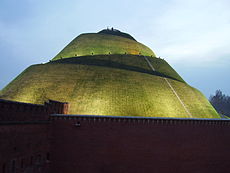Mound
This article needs additional citations for verification. (May 2020) |


A mound is a
Archaeology
North American archaeology
In the archaeology of the United States and Canada, a mound is a deliberately constructed elevated earthen structure or earthwork, intended for a range of potential uses. In European and Asian archaeology, the word "tumulus" may be used as a synonym for an artificial hill, particularly if the hill is related to particular burial customs.
While the term "mound" may be applied to historic constructions, most mounds in the United States are pre-Columbian earthworks, built by
While these mounds are perhaps not as famous as
Mounds and related earthworks are the only significant monumental construction in pre-Columbian Eastern and Central North America. peoples.[citation needed]
Mounds are given different names depending on which culture they strive from. They can be located all across the world in spots such as Asia, Europe and the Americas. "Mound builders" have more commonly been associated with the mounds in the Americas. They all have different meanings and sometimes are constructed as animals and can be clearly seen from aerial views.
India
Kankali Tila

Archaeology elsewhere

Mound, as a technical term in archaeology, is not generally in favor in the rest of the world.[citation needed] More specific local terminology is preferred, and each of these terms has its own article (see below).
Mound types
- Cairn
- Effigy mound
- Kofun (Japanese mounds)
- Platform mound
- Subglacial mound
- Tell (also includes multi-lingual synonyms for mounds in the Near East)
- Terp (European dwelling mounds located in wetlands like flood plains and salt marshes)
- Tumulus (barrow)
- Bank barrow
- Bell barrow
- Bowl barrow
- Chambered long barrow
- Kurgan
- Long barrow
- Oval barrow
See also
- List of burial mounds in the United States
- Fort Ancient
- Kofun period
- Kurgan hypothesis
- Mississippian Period
- Neolithic Europe
- Olmec
- Petroform
- Pyramid
- Prehistoric Britain
- Stupa
- Woodland Period
- Ziggurat
- Animals
References
- ^ National Park Service (August 30, 2015). "Effigy Moundbuilders". National Park Service. Retrieved August 30, 2015.
- ^ Smith, C. R. (March 9, 2000). "An Introduction to North America's Native People: Adena". Cabrillo College. Retrieved August 30, 2015.
- ^ Smith, Vincent Arthur (1901). The Jain stupa and other antiquities of Mathura. Retrieved 14 November 2015.
External links
 The dictionary definition of mound at Wiktionary
The dictionary definition of mound at Wiktionary- . Encyclopædia Britannica. Vol. 18 (11th ed.). 1911.
